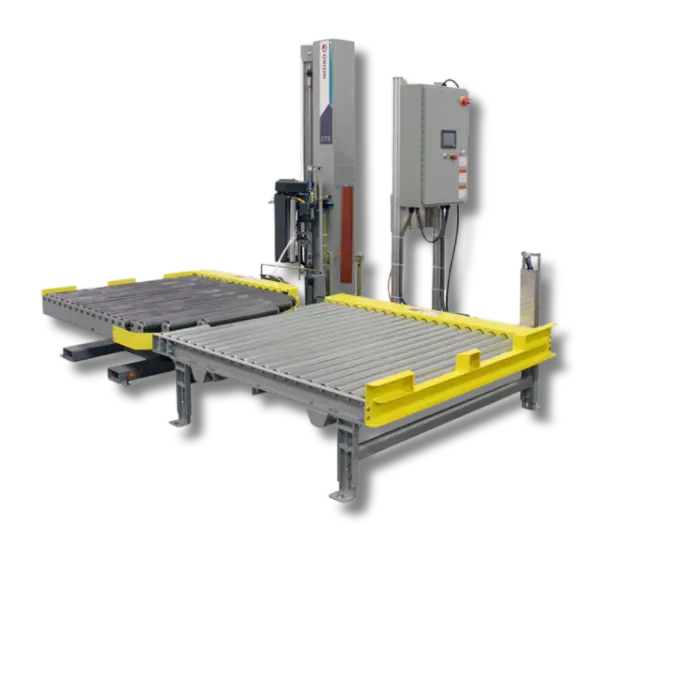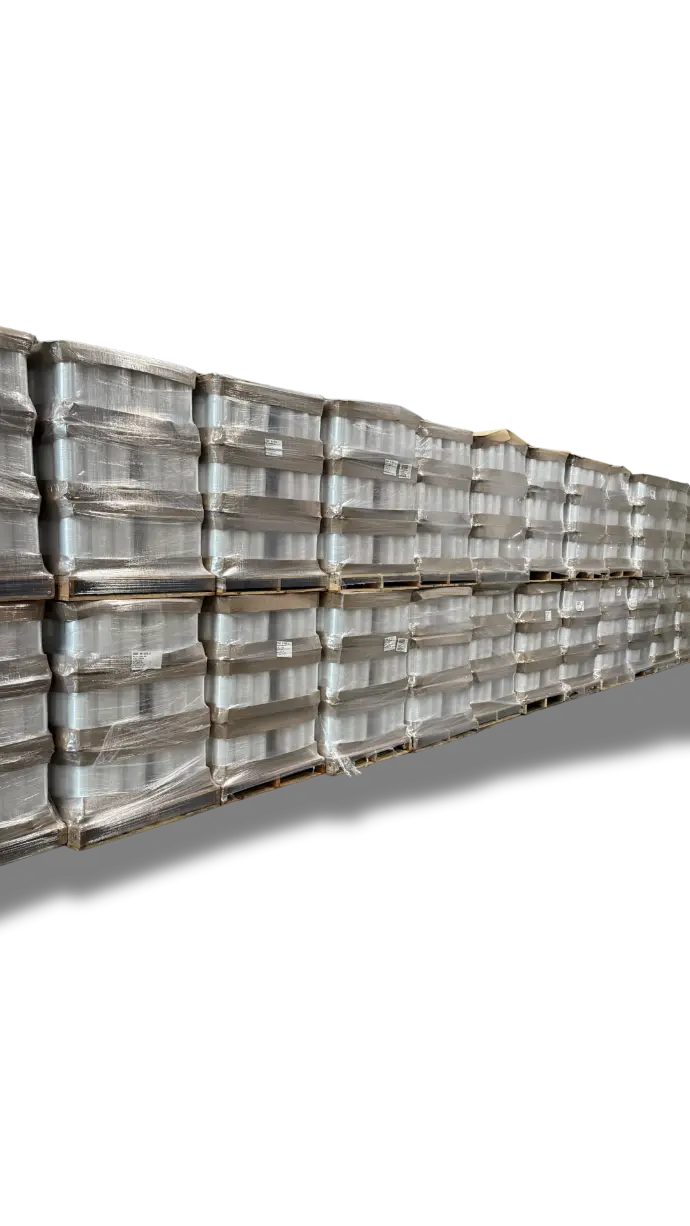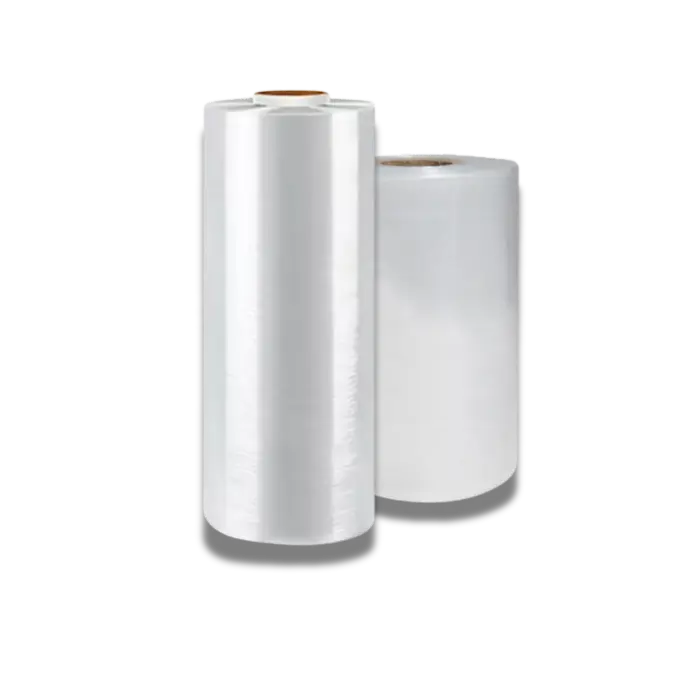Stretch Film Equipment
Enhance Stability & Reduce Waste with High-Quality Stretch Wrapping Solutions
Choosing the Right Stretch Wrap System:
Semi-Automatic vs. Automatic Solutions
Semi-Automatic Stretch Wrap Systems with Low-Profile Turntables
Semi-automatic stretch wrap machines with low-profile turntables are ideal for businesses that need an efficient yet affordable solution for wrapping standard pallet sizes. These machines wrap pallets up to 53” x 53” and 82” high, with an output of 30 – 50 pallets per hour. They are perfect for use with forklifts or pallet jacks, making them a good fit for warehouses or operations with moderate throughput. Additionally, these systems can be equipped with a pre-stretch option, which elongates the stretch film before application, helping businesses save on film costs while enhancing load security. These machines are great for companies looking to optimize their packaging process without heavy capital investment.
Semi-Automatic Stretch Wrap Systems with High-Profile Turntables
For operations with heavier or more irregularly shaped loads, semi-automatic machines with high-profile turntables are a great choice. The elevated platform design allows for easier floor cleaning, reducing maintenance downtime and improving the overall efficiency of your packaging area. These machines are suitable for wrapping heavier loads, typically ranging from 4,000 to 5,000 lbs, and are designed specifically for forklift loading. With motorized pre-stretch options available, these systems offer additional flexibility and cost savings by maximizing film stretch, resulting in stronger and more secure pallet loads. High-profile turntable machines are a perfect option for businesses handling heavier or bulkier products requiring efficient wrapping with minimal manual effort.
Fully Automatic Stretch Wrap Systems
For businesses that require high throughput and minimal operator involvement, fully automatic stretch wrap systems are the best option. These machines offer complete automation with automatic film clamping, cutting, and film tail treatment, eliminating the need for manual intervention and increasing wrapping efficiency. Fully automatic stretch wrap systems are designed for conveyorized use, allowing for continuous operation without interruption. With the ability to wrap up to 60 pallets per hour, these heavy-duty machines are perfect for high-volume environments and can handle light or unstable loads. The no-operator design ensures consistent, high-quality wrapping while reducing labor costs, making it ideal for businesses looking to scale operations and streamline their packaging process.
How to Choose the Right System for Your Business
Choosing the right stretch wrap system depends on several factors, including the volume of pallets you need to wrap, load size and weight, and your operational setup. For lower-volume operations with standard-sized pallets, semi-automatic systems with low-profile turntables offer a cost-effective solution that still provides reliable performance. For operations handling larger or heavier loads, a high-profile turntable system provides the additional strength and functionality needed. On the other hand, if your business demands high throughput and minimal manual effort, a fully automatic system offers the highest level of automation, allowing you to wrap pallets quickly and efficiently without requiring operator involvement. Consider your business’s specific needs to select the stretch wrap system that maximizes productivity and cost savings.


Decrease Labor Costs and Increase Productivity
A stretch film wrapping machine can help your business cut labor costs, reduce film waste, and improve efficiency by automating the pallet wrapping process. Instead of tying up valuable employees with manual pallet wrapping, a semi-automatic or automatic stretch wrap machine allows them to focus on higher-value tasks while also minimizing workplace injuries caused by repetitive motion.
Why Choose a Stretch Wrap Machine?
Top and Bottom Wrap Coverage: Stretch wrap machines provide thorough coverage by applying multiple layers at the top and bottom of pallets. This reinforces load stability, prevents shifting during transit, and adds extra protection against dust, moisture, and potential impact.
Consistent Application: Unlike manual wrapping, machines ensure consistent and secure application of stretch film, reducing the risk of loose or inadequately layered wraps that could lead to damage.
Variety of Models: Choose from a range of models tailored to your needs, including turntable machines for standard pallet sizes and robotic or rotary arm machines for lighter loads or mobile wrapping solutions.
Efficiency and Speed: These machines can dramatically increase wrapping speeds, allowing your business to handle more in less time, and potentially pay for themselves within months.
Environmental Impact: With powered stretching heads, these machines maximize film stretch, reducing film consumption and contributing to lower costs and environmental impact.
Investing in stretch wrap machines not only enhances your packaging efficiency but also offers a strategic edge in logistics management. By automating this critical aspect of your operations, you ensure that your products reach their destination safely and in pristine condition.


Understanding Top Wrap and Bottom Wrap in Pallet Wrapping
When it comes to securing pallet loads, two crucial techniques are employed: top wrap and bottom wrap. These methods play a significant role in keeping goods stable during transport.
Top Wrap
- What It Is: The top wrap refers to the stretch film applied around the uppermost section of a pallet load.
- Purpose: It serves to stabilize and secure the load, minimizing movement or slipping during transport.
- Application: Typically involves 2 to 4 rotations of wrapping film, the number of wraps can vary based on the weight and stability needs of the load.
Bottom Wrap
- What It Is: This involves wrapping the stretch film around the base section of the pallet.
- Purpose: Secures the bottom of the load to the pallet, enhancing overall stability.
- Application: Generally, like the top wrap, it includes 2 to 4 rotations. The exact number of wraps is adjusted depending on the type and weight of the items being shipped.
Both top and bottom wraps are essential for ensuring that the contents of a pallet remain intact and safe from damage during handling and transit. They are widely used across various industries to protect goods and maintain logistics efficiency.
Would you like more information?